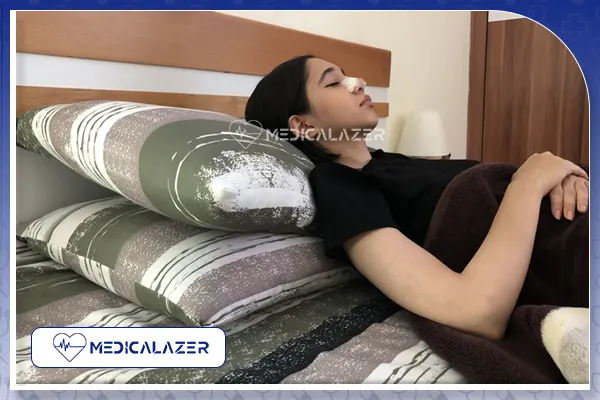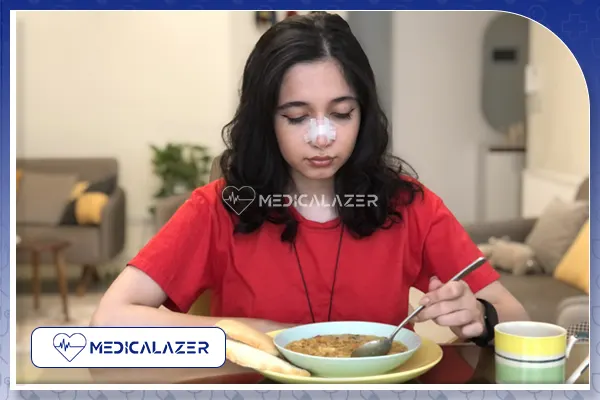Rhinoplasty, commonly known as a nose job, is a surgical procedure performed to reshape, resize, or enhance the appearance and/or function of the nose. Swelling is a common side effect of rhinoplasty and understanding the stages of swelling after a nose job can help you better prepare for the recovery process. It’s important to note that the exact timeline and severity of post rhinoplasty swelling can vary from person to person.

Rhinoplasty Swelling Timeline
Below you can find different stages of swelling after rhinoplasty, progression and healing timeline:
Immediate Swelling (1 week rhinoplasty swelling)
After rhinoplasty, you can expect immediate swelling in and around the nose. This initial swelling is the most significant and usually peaks within the second or third day after the nose job. During this stage, your nose may appear larger than its final result, and you may experience bruising around the eyes and face.
What are the worst days of swelling after rhinoplasty?
Generally, the swelling will peak on the second or third day after your nose job, especially during the early morning when you wake up. That is why it is better to remain elevated as much as possible.
Subacute Swelling (1-4 Weeks)
Over the next few weeks, the swelling will gradually subside, but it will still be noticeable.
Is nose still swollen 2 weeks after rhinoplasty?
Yes, it is common for the nose to still be swollen two weeks after rhinoplasty. Swelling is a normal part of the healing process and can persist for several weeks or even months after the surgery.
What to expect 3 weeks after rhinoplasty?
Am I still swollen 3 weeks after rhinoplasty? While the majority of the swelling diminishes, some residual swelling remains. During this stage, your nose may appear more refined, but the final result is still not apparent.
Swelling 4 weeks after rhinoplasty:
Within the first month following nose job, most of the swelling will go down.
Early Resolution (1-3 Months)
At this stage, most of the obvious swelling will have resolved, and your nose will begin to show more of its final shape. However, some mild swelling may still persist, particularly in the nasal tip area. The changes during this stage are usually subtle but noticeable.
Is my nose still swollen 2 months after rhinoplasty?
Based on rhinoplasty swelling timeline, the healing process after nose job is a gradual one, and it varies from person to person. It’s not uncommon for individuals to experience fluctuations in swelling during the recovery period.
Intermediate Resolution (3-6 Months)
The swelling continues to diminish, and your nose gradually approaches its final shape. However, it’s important to remember that the healing process can vary, and some individuals may take longer to reach this stage and see the final shape of their noses.
Final Resolution (6-12 Months)
After approximately six months, the remaining swelling is minimal, and your nose will appear close to its final outcome. It is sometimes said that after 6 months, almost 80% of swelling has disappeared and the majority of people will see significant improvements in the appearance of their noses. However, it’s essential to keep in mind that subtle changes may continue to occur over the next few months, and the full healing process can take up to a year or more. some factors like surgical technique, thick skin, ethnicity, and post-operative care can contribute to nasal bridge swelling after rhinoplasty lasting longer in certain individuals.
What are rhinoplasty tip swelling stages?
Immediately after surgery, the tip of your nose will be the most swollen. This is due to the trauma caused by the surgery and the accumulation of fluids in the tissues. The swelling will be at its peak during the first few days after the procedure. Within the first few weeks, you will notice a significant reduction in swelling compared to the immediate postoperative period. From around the first month to the third-month post-surgery, the swelling in the tip area will gradually continue to decrease. Beyond the three-month mark, the remaining swelling will continue to diminish gradually. The tip will become more refined as the tissues heal and settle.
Supplements to reduce swelling after rhinoplasty
Several vitamins such as Vitamin C and Bromelain, derived from pineapples, are known for their anti-inflammatory properties. They may help reduce swelling and bruising after surgery.
However, it’s important to follow the recommended dosage and consult your surgeon or a healthcare professional before taking them.
How to reduce swelling after rhinoplasty cast removal?
After the cast removal following rhinoplasty, it is normal to experience swelling in the nose. This swelling is a common occurrence and typically not a cause for concern. However, there are certain measures you can take to help minimize the swelling.
- Keeping your head elevated: By placing a pillow under your head while sleeping or resting, you can keep your head higher than your body. This can encourage fluid drainage and reduce swelling.

- Massage: Massage techniques may be recommended by certain surgeons to aid in the reduction of swelling. However, it is essential to adhere to your surgeon’s specific instructions and avoid attempting any form of massage without their guidance.
- Eating a balanced diet: It is essential to moderate sodium intake since excessive amounts can cause fluid retention and heightened swelling. Furthermore, maintaining proper hydration by drinking enough water is vital as it aids in the elimination of toxins from the body and assists in minimizing swelling.

- Avoiding drinking alcohol and tobacco: Avoiding alcohol and tobacco is essential during the recovery period as they can hinder the healing process and exacerbate swelling. It is recommended to refrain from consuming alcohol and smoking until the recovery is complete.
- Avoiding heavy activities: To minimize swelling, it is important to avoid strenuous activities that can increase blood flow to the face. Follow your surgeon’s instructions regarding activity restrictions, which may include avoiding heavy lifting, bending over, or engaging in intense exercise during the initial healing phase.
 Medicalazer Online Health and Beauty Magazine
Medicalazer Online Health and Beauty Magazine